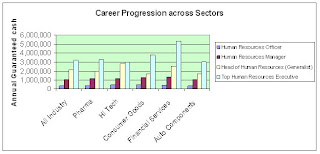The compensation in the Human Resources function is seen to vary across different sectors in India and some sectors seem to be commanding a premium over certain others. One striking example of this is the Financial Services industry, where the compensation of HR professionals shows a huge premium over any other sector in India. This is true across 4 representative levels which are most common in the industry, namely the officer cadre, the managerial cadre, the senior manager cadre and the top management cadre. This observation is seen to be true for Annual Guaranteed Cash, as well as the Annual Total remuneration, suggesting strongly the premium that HR professionals command in the Financial Services sector.
 On the other end of the spectrum is the Auto Component industry, where the compensation for HR professionals across levels seems to be below any other sector in consideration. The other sectors where the compensation figures for HR professionals seem to suggest a premium is the Consumer Goods (FMCG) sector and the Information Technology sector. However, unlike the financial services sector, where this premium is commanded across levels, it is observed that the top management compensation in IT and the Senior Manager level in FMCG lag the market while all other levels seem to be above the market.
On the other end of the spectrum is the Auto Component industry, where the compensation for HR professionals across levels seems to be below any other sector in consideration. The other sectors where the compensation figures for HR professionals seem to suggest a premium is the Consumer Goods (FMCG) sector and the Information Technology sector. However, unlike the financial services sector, where this premium is commanded across levels, it is observed that the top management compensation in IT and the Senior Manager level in FMCG lag the market while all other levels seem to be above the market.
Career Progression Analysis
The career progression in any function is linked to compensation and this section explores the increase in compensation during a career jump within the HR function across sectors. It is seen that the most striking increase in compensation is when one moves from an officer level to a managerial level. This is seen to be true across sectors without exception. Even the degree of increase is seen to be fairly consistent across sectors, with the increase being in the range of 180% (FMCG) to 240% (Pharmaceutical).
 The increase noted when there is a progression from Management to Senior Management in HR is less dramatic. This is true for all sectors, without exception. However, it is seen that some sectors downplay this progression, notably the Consumer Goods industry (30%) while some other sectors have more telling hikes in compensation (Financial Services and Pharmaceutical sectors giving 89% and 75% resp).
The increase noted when there is a progression from Management to Senior Management in HR is less dramatic. This is true for all sectors, without exception. However, it is seen that some sectors downplay this progression, notably the Consumer Goods industry (30%) while some other sectors have more telling hikes in compensation (Financial Services and Pharmaceutical sectors giving 89% and 75% resp).
This trend continues in the progression from the Senior Management level to the Top Management level. Here, the most striking example is the Consumer Goods or FMCG sector, where the sector seems to reward this movement very well, with the increase to the tune of 130%. Other sectors are less striking in their increases, with increases ranging from 63% (Pharmaceuticals) to 109% (Financial Services).
Sub Function Analysis
Different sectors are seen to reward different skill sets within the HR function. Compensation and Benefits specialization in HR is seen to command a slight premium in the market across sectors at the managerial level with sectors like FMCG paying more to a Compensation and Benefits manager as compared to an HR Generalist. This could be in light of Rewards as a philosophy for Attraction and Retention emerging into the limelight. This premium is seen to be almost 33% in sectors like FMCG. Further, even in sectors like IT, this trend is noted, though the premium is not of the magnitude seen in the Consumer Goods space. In this sector, Recruitment as a specialization is seen to command a premium, with Recruitment Managers getting paid differentially. Another observation is that Employee Relations Manager commands a premium in manufacturing sectors like Auto Components industry. A slightly deviant trend is noted in the pharmaceutical industry, where the HR Generalist is paid well above any of the sub function managers.
Variable Pay Analysis
The emphasis on Variable Pay or Pay for performance continues to be paramount, with companies in every sector using this as a tool for attracting and retaining talent. This trend is consistent across sectors; however the extent of variable pay in the annual total remuneration of an incumbent varies widely. A notable example here is the Oil and Gas industry, where the variable pay as a component of total CTC is the highest seen across levels. At the top management level, the sectors which are seen to pay a huge portion of CTC as variable pay are Oil and Gas and Financial Services. This percentage is seen to be as high as 27% in these sectors for the top HR executive. This percentage does not show much variation in any other sector, with values ranging between 20 to 23%. At the junior levels, (HR officer) the chemical industry is seen to pay a higher variable pay portion than any other sector. The FMCG space is seen to be paying a good percentage as variable pay to the senior management and above, with the variable pay at the managerial and officer level falling below that of other sectors.

* Reference Times Ascent








No comments:
Post a Comment